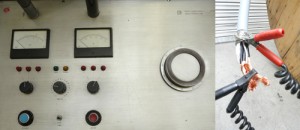Cables without a jacket may not be used as a substitute for a jacketed cable or as an extension cable. This also is the case for connecting Class 2 cables to equipment, unless the cables in the construction spec have been defined as cables for extra light duty in a fixed installation.
The corresponding VDE and HD regulations shall be observed for the cables used in mining operations, quarrying, and equipment e.g. cranes with spring-loaded reeling devices.
Voltage

The rated voltage for a cable is the voltage for which a cable is designed and defines the electrical testing requirements.
The rated voltage is expressed as the ratio of two values, U0/U, where U0 is the effective value (root mean square or r.m.s.) of the voltage between any insulated conductor and the “ground” (metal covering of the cable or surrounding medium). U is the effective value (r.m.s.) between any two-phase conductors of a multi-conductor cable or system of single conductor cables.
In an alternating current (AC) system, the rated voltage of a cable should be at least equal to the nominal voltage given by the U0/U value. In direct current (DC) system, the rated voltage of the system should be no higher than 1.5 times that of the nominal voltage of the cable.
Note: The operating voltage of a system may permanently exceed the rated voltage for the cable by 10%.
Current carrying capacity
The nominal cross-section of each chosen conductor should be large enough so that the current carrying capacity is not less than the maximum continuous current that flows through the conductor under normal operating conditions. The limiting temperature with respect to the current carrying capacity should not exceed the cable insulation and jacket required.
Regulations define how a cable should be installed along with the amount of current the cable can carry.
Other factors may also be included in the values given for the load rating to allow for other conditions, such as:
- cable grouping
- excess current protection
- ambient temperature
- reeled/drummed cables
- thermal insulation
- current frequency (if other than 50 Hz)
- harmonic wave effects
Serious damage can occur if cables are operated for longer periods of time above recommended current ratings and can lead to early failure or considerable deterioration of the cable’s performance.
Thermal influences
Cables should be selected, located and installed so that the intended heat dissipation is not inhibited and does not present a fire hazard to adjacent materials.
The temperature limits for individual cables are specified by the manufacturer, which under no circumstances should these values be exceeded.
Read part 1 in this series here, part 2 here and part 3 here.
Contributed by Kevin Siegel, Communications Manager
Helukabel USA
www.helukabel.com


Leave a Reply
You must be logged in to post a comment.